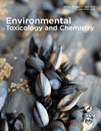Environmental Toxicology and Chemistry 31(4)
Overview of new articles on POPs in a new issue of the Environmental Toxicology and Chemistry journal.

pages 705–711
Jiang-Ping Wu, Ying Zhang, Xiao-Jun Luo, She-Jun Chen and Bi-Xian Mai
- Contamination with agricultural pesticides such as dichlorodiphenyltrichloroethane (DDT) and its metabolites, dichlorodiphenyldichloroethylene (DDE) and dichlorodiphenyldichloroethane (DDD), is among several proposed stressors contributing to the global declines in amphibian populations and species biodiversity. These chemicals were examined in insects and in the muscle, liver, and eggs of rice frogs (Rana limnocharis) from the paddy fields of an agricultural site in South China.
pages 717–723
Yali Shi, Jieming Wang, Yuanyuan Pan and Yaqi Cai
- In the present study, the levels of 14 perfluorinated compounds (PFCs) were analyzed in the blood, liver, muscle, brain, and eggs of popular farmed freshwater fish from Beijing.
pages 731–738
Yan-Hong Zeng, Xiao-Jun Luo, Hua-Shan Chen, Le-Huan Yu, She-Jun Chen and Bi-Xian Mai
- The gastrointestinal absorption, metabolic debromination, and hydroxylation of three commercial brominated diphenyl ether (BDE) mixtures were separately studied in juvenile common carp. The absorption rate of penta-BDE was higher than that of octa- and deca-BDE, likely because of the lower molecular volumes of its major congeners.
pages 794–803
Tiago Natal-da-Luz, Iwa Lee, Rudo A. Verweij, Paula V. Morais, Martin J.M. Van Velzen, José Paulo
- Earthworms may promote the biodegradation of polycyclic aromatic hydrocarbons (PAHs) in soil, but the mechanism through which they exert such influence is still unknown. To determine if the stimulation of PAH degradation by earthworms is related to changes in microbial communities, a microcosm experiment was conducted consisting of columns with natural uncontaminated soil covered with PAH-contaminated dredge sediment.
pages 804–812
Kristina Arnoldsson, Anna Norman Haldén, Leif Norrgren and Peter Haglund
- High levels of polychlorinated dibenzo-p-dioxins and dibenzofurans (PCDD/Fs), mono- and non-ortho-polychlorinated biphenyls (PCBs), and polybrominated dibenzo-p-dioxins (PBDDs) are found in fish from coastal areas in the Baltic Sea, which may cause ecotoxicological effects. To increase our understanding of the persistency of the emerging pollutants polybrominated dibenzo-p-dioxins and dibenzofurans (PBDD/Fs), fish feed was spiked with 21 PBDD/Fs, 17 PCDD/Fs, and 30 PCBs and fed to zebrafish (Danio rerio).
21.3.2012




